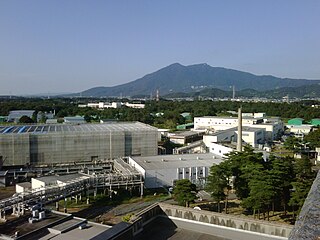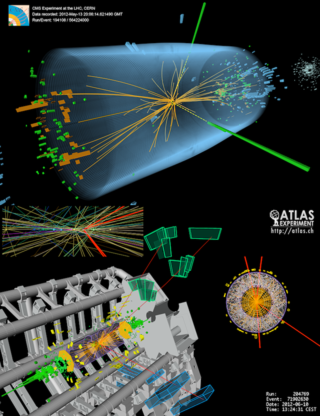Related Research Articles

In particle physics, an elementary particle or fundamental particle is a subatomic particle that is not composed of other particles. Particles currently thought to be elementary include electrons, the fundamental fermions, as well as the fundamental bosons, which generally are force particles that mediate interactions among fermions. A particle containing two or more elementary particles is a composite particle.

Particle physics or high energy physics is the study of fundamental particles and forces that constitute matter and radiation. The fundamental particles in the universe are classified in the Standard Model as fermions and bosons. There are three generations of fermions, although ordinary matter is made only from the first fermion generation. The first generation consists of up and down quarks which form protons and neutrons, and electrons and electron neutrinos. The three fundamental interactions known to be mediated by bosons are electromagnetism, the weak interaction, and the strong interaction.

The European Organization for Nuclear Research, known as CERN, is an intergovernmental organization that operates the largest particle physics laboratory in the world. Established in 1954, it is based in a northwestern suburb of Geneva, on the France–Switzerland border. It comprises 23 member states. Israel, admitted in 2013, is the only non-European full member. CERN is an official United Nations General Assembly observer.

The Large Hadron Collider (LHC) is the world's largest and highest-energy particle collider. It was built by the European Organization for Nuclear Research (CERN) between 1998 and 2008 in collaboration with over 10,000 scientists and hundreds of universities and laboratories, as well as more than 100 countries. It lies in a tunnel 27 kilometres (17 mi) in circumference and as deep as 175 metres (574 ft) beneath the France–Switzerland border near Geneva.
In particle physics, the W and Z bosons are vector bosons that are together known as the weak bosons or more generally as the intermediate vector bosons. These elementary particles mediate the weak interaction; the respective symbols are
W+
,
W−
, and
Z0
. The
W±
bosons have either a positive or negative electric charge of 1 elementary charge and are each other's antiparticles. The
Z0
boson is electrically neutral and is its own antiparticle. The three particles each have a spin of 1. The
W±
bosons have a magnetic moment, but the
Z0
has none. All three of these particles are very short-lived, with a half-life of about 3×10−25 s. Their experimental discovery was pivotal in establishing what is now called the Standard Model of particle physics.

The Large Electron–Positron Collider (LEP) was one of the largest particle accelerators ever constructed. It was built at CERN, a multi-national centre for research in nuclear and particle physics near Geneva, Switzerland.
A collider is a type of particle accelerator that brings two opposing particle beams together such that the particles collide. Colliders may either be ring accelerators or linear accelerators.

The Compact Linear Collider (CLIC) is a concept for a future linear particle accelerator that aims to explore the next energy frontier. CLIC would collide electrons with positrons and is currently the only mature option for a multi-TeV linear collider. The accelerator would be between 11 and 50 km long, more than ten times longer than the existing Stanford Linear Accelerator (SLAC) in California, USA. CLIC is proposed to be built at CERN, across the border between France and Switzerland near Geneva, with first beams starting by the time the Large Hadron Collider (LHC) has finished operations around 2035.

The International Linear Collider (ILC) is a proposed linear particle accelerator. It is planned to have a collision energy of 500 GeV initially, with the possibility for a later upgrade to 1000 GeV (1 TeV). Although early proposed locations for the ILC were Japan, Europe (CERN) and the USA (Fermilab), the Kitakami highland in the Iwate prefecture of northern Japan has been the focus of ILC design efforts since 2013. The Japanese government is willing to contribute half of the costs, according to the coordinator of study for detectors at the ILC.

The High Energy Accelerator Research Organization, known as KEK, is a Japanese organization whose purpose is to operate the largest particle physics laboratory in Japan, situated in Tsukuba, Ibaraki prefecture. It was established in 1997. The term "KEK" is also used to refer to the laboratory itself, which employs approximately 695 employees. KEK's main function is to provide the particle accelerators and other infrastructure needed for high-energy physics, material science, structural biology, radiation science, computing science, nuclear transmutation and so on. Numerous experiments have been constructed at KEK by the internal and international collaborations that have made use of them. Makoto Kobayashi, emeritus professor at KEK, is known globally for his work on CP-violation, and was awarded the 2008 Nobel Prize in Physics.

Jonathan Richard Ellis is a British theoretical physicist who is currently Clerk Maxwell Professor of Theoretical Physics at King's College London.

A particle accelerator is a machine that uses electromagnetic fields to propel charged particles to very high speeds and energies, and to contain them in well-defined beams.

The Higgs boson, sometimes called the Higgs particle, is an elementary particle in the Standard Model of particle physics produced by the quantum excitation of the Higgs field, one of the fields in particle physics theory. In the Standard Model, the Higgs particle is a massive scalar boson with zero spin, even (positive) parity, no electric charge, and no colour charge that couples to mass. It is also very unstable, decaying into other particles almost immediately upon generation.
A Muon Collider is a proposed particle accelerator facility in its conceptual design stage that collides muon beams for precision studies of the Standard Model and for direct searches of new physics. Muons belong to the second generation of leptons, they are typically produced in high-energy collisions either naturally or artificially. The main challenge of such a collider is the short lifetime of muons.

The search for the Higgs boson was a 40-year effort by physicists to prove the existence or non-existence of the Higgs boson, first theorised in the 1960s. The Higgs boson was the last unobserved fundamental particle in the Standard Model of particle physics, and its discovery was described as being the "ultimate verification" of the Standard Model. In March 2013, the Higgs boson was officially confirmed to exist.

Sau Lan Wu is a Chinese American particle physicist and the Enrico Fermi Distinguished Professor of Physics at the University of Wisconsin-Madison. She made important contributions towards the discovery of the J/psi particle, which provided experimental evidence for the existence of the charm quark, and the gluon, the vector boson of the strong force in the Standard Model of physics. Recently, her team located at the European Organization for Nuclear Research (CERN), using data collected at the Large Hadron Collider (LHC), was part of the international effort in the discovery of a boson consistent with the Higgs boson.

The idea that matter consists of smaller particles and that there exists a limited number of sorts of primary, smallest particles in nature has existed in natural philosophy at least since the 6th century BC. Such ideas gained physical credibility beginning in the 19th century, but the concept of "elementary particle" underwent some changes in its meaning: notably, modern physics no longer deems elementary particles indestructible. Even elementary particles can decay or collide destructively; they can cease to exist and create (other) particles in result.
The Circular Electron Positron Collider (CEPC) is a proposed Chinese electron positron collider for experimenting on the Higgs boson. It would be the world's largest particle accelerator with a circumference of 100 kilometres (62 mi).

The Future Circular Collider (FCC) is a proposed particle accelerator with an energy significantly above that of previous circular colliders, such as the Super Proton Synchrotron, the Tevatron, and the Large Hadron Collider (LHC). The FCC project is considering three scenarios for collision types: FCC-hh, for hadron-hadron collisions, including proton-proton and heavy ion collisions, FCC-ee, for electron-positron collisions, and FCC-eh, for electron-hadron collisions.
The Snowmass Process is a particle physics community planning exercise sponsored by the Division of Particles and Fields of the American Physical Society. During this process, scientists develop a collective vision for the next seven to ten years for particle physics research in the US.
References
- ↑ Charley, Satah (June 22, 2020). "European Strategy prioritizes Higgs factory" . Retrieved 24 April 2022.
- ↑ "ICFA Statement Regarding Higgs Factory Development and the ILC". International Committee for Future Accelerators. Interactions.org. Retrieved 24 April 2022.
- ↑ Walchover, Natalie (March 4, 2019). "The Physics Still Hiding in the Higgs boson". Quanta Magazine. Retrieved 24 April 2022.
- ↑ "Targeting a Higgs factory". CERN Courier. 27 January 2021. Retrieved 24 April 2022.